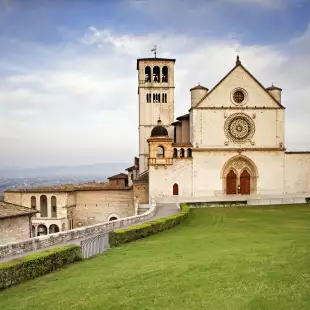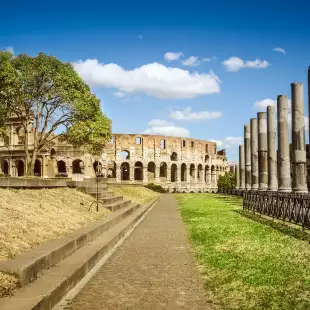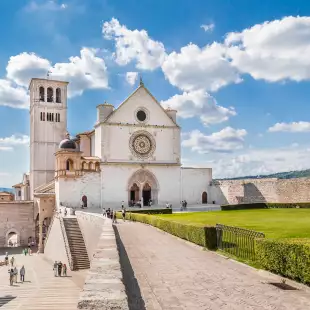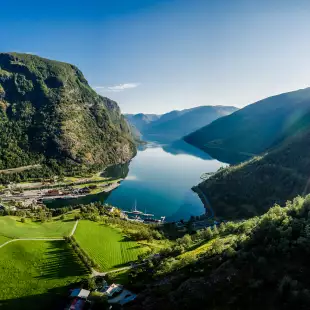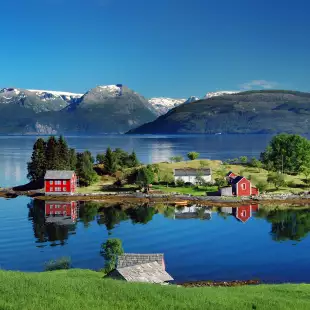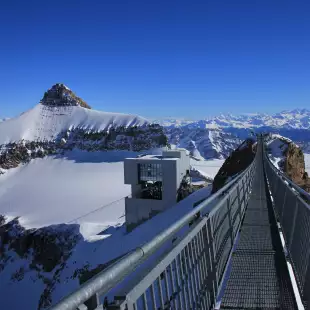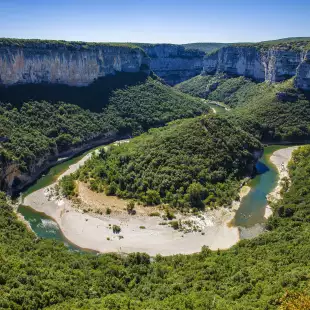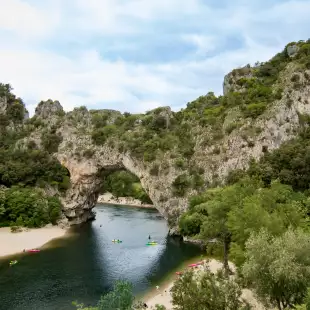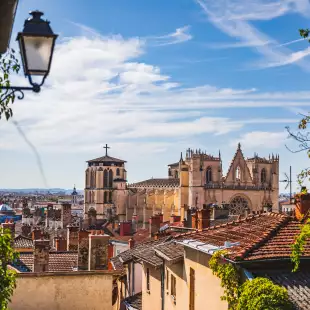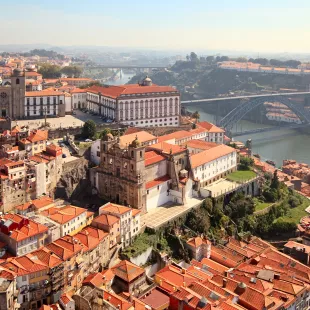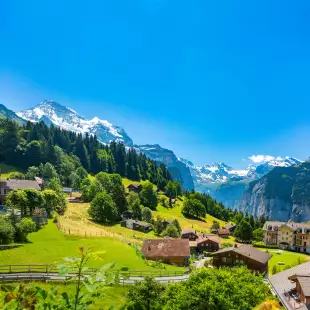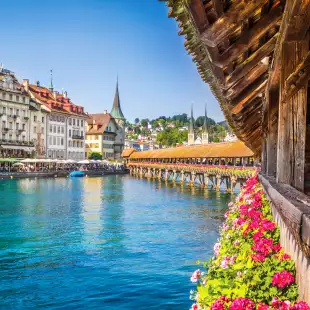The 10 Best Natural Wonders of Europe

Discover the 10 best natural wonders of Europe including Verdon Gorge, the Dolomites and the Matterhorn.
Magnificent mountains, gorgeous gorges, towering waterfalls – Europe has its fair share of natural wonders, and each one is an awe-inspiring joy. A highlight of any European tour or visited while aboard European cruises, here are 10 of the best natural wonders that, once seen, are never forgotten.
The Top 10 Natural Wonders Of Europe
1. The Dolomites, Italy
With its 18 jagged peaks, the Dolomites mountain range in the northern Italian Alps is a breath-taking sight. World-renowned for their sheer cliffs and narrow, deep valleys, depending on the time of day – and the season – the mountains change colour. A pinkish hue at dawn, the Dolomites can turn a vibrant red at sunset. Then, of course, in winter, the ridges are spectacular covered in snow. Ski the famous Sella Ronda circuit or embark on a Dolomites walking tour – they’re easily accessible and only a two-hour journey from Venice.

2. Norwegian Fjords, Norway
Visitors to Norway can enjoy another of the best natural wonders in Europe. The country’s remarkable fjords – and there are over 1,000 – are thought of as Norway’s main roads, a scenic way to travel from one destination to the next. Cruising through the dramatic sea inlets, surrounded by majestic cliffs, today’s access routes were created some 2.5 million years ago, the result of the submergence of a glaciated valley. June, July and August are popular months for a Norwegian fjord cruise, when travellers will also experience long summer days and short nights.

3. Verdon Gorge, France
Located in central Provence, Verdon Gorge is known as the Grand Canyon of France. This natural wonder is popular with hikers, rock climbers, twitchers, kayakers and visitors who want to admire its beauty. The gorge runs 25 picturesque kilometres between towering limestone walls – some twice the height of Paris’s Eiffel Tower. The water in the ravine is a striking turquoise colour and attracts keen wild swimmers too – it’s a great day trip from the French Riviera. For the best views of Verdon Gorge from the road high above, provided you don’t suffer from vertigo, drive the northern route.

Read 20 Reasons to Visit Provence here.
4. The Matterhorn, Switzerland
Dominating the Alps mountain range, the mighty Matterhorn is 4,478 metres tall and thought to be at least 50 million years old. Instantly recognisable, even to mountain novices, thanks to its vast and near-symmetrical pyramid peak, this natural wonder was first climbed in 1865 by a seven-man team. The first female scaled the Matterhorn six years later – wearing a long flannel skirt. Today, visitors can gaze at the horn-shaped peak while enjoying a scenic train journey from Zermatt along the cog railway to the summit of the Gornergrat. Prepare to be wowed.

5. Plitviče Lakes, Croatia
A list of the best natural wonders of Europe must include Croatia’s oldest and largest national park. At Plitviče Lakes, thousands of years of water flowing over limestone, chalk and moss has created natural dams, resulting in 16 impressive, terraced lakes, linked to one another by streams and waterfalls. The tallest waterfall is Veliki Slap, which falls 78 metres – during cold winters, it freezes into a giant ice sculpture. The different colours of the upper and lower lakes make for an entrancing sight too – some are green, others blue, while a few appear transparent.

6. Douro River Valley, Portugal
One of the world’s oldest wine regions, Portugal’s Douro Valley is a UNESCO-listed natural wonder dotted with charming villages and terraces of olives, almonds and grapes. Best appreciated on a Douro river cruise, while in Porto you can learn about age-old traditions – grapes are still pressed by feet – and sample the region’s quality wine and port in the city’s famous cellars. Cruising further inland, passing lush hillsides and soaring cliffs, a river cruise is a perfect way to soak up the region’s natural beauty. Spring and autumn are the best seasons to visit.

Read about Cruising Portugal’s Picturesque Douro Valley here.
7. Black Forest, Germany
Walking through the Black Forest in Germany is like finding yourself in the middle of a Brothers Grimm fairy tale. Not surprisingly, as legend claims the authors were inspired by the densely forested mountain range. On a trek or cycle through the dark woods, you feel as if you could stumble upon the setting for Little Red Riding Hood. A natural wonder that gets its name for its canopy of evergreens, this expanse of unspoilt hills, lakes and forests can be visited while on a Rhine river cruise or one of many Black Forest Germany holidays – it’s a year-round destination.

8. Lake Como, Italy
Visiting the wishbone-shaped Lake Como on European tours is like a dream come true. This tranquil natural wonder situated just 50 miles north of Milan offers plenty of serene lakeside settings from where you can treasure the calming view. Extending some 56 square miles, Lake Como attracts watersport enthusiasts, as well as walkers keen to hike along cypress-lined paths, through quaint hamlets and fishing villages. But Italy’s third-largest lake is also a destination where it’s easy to slow down. Time seems to stand still, so you can relax and unwind too.

9. Gullfoss, Iceland
A list of natural wonders of Europe must include Iceland’s most dramatic waterfall. Gullfoss, in the country’s Haukadalur Valley, is an unforgettable sight, especially if you visit on a sunny day when hundreds of rainbows appear in clouds of spray. During the summer, water cascades down Gullfoss in two stages, falling 32 metres into a deep crevice below. The waterfall can freeze into glistening ice in extreme winters.

10. Giant’s Causeway, Northern Ireland
Closer to home and a highlight of Ireland tours, the Giant’s Causeway in County Antrim is a bizarre yet fascinating natural phenomenon. At the foot of a soaring amphitheatre along a rugged coastline, the Causeway itself comprises of three modestly sized fingers of naturally created crazy paving. The 37,000 hexagonal basalt columns formed as flows of molten lava cooled and contracted, fracturing vertically with mysterious regularity to produce what looks like a fiendishly complicated giant keyboard – though according to folklore, the causeway is what’s left of a bridge to Scotland built by the giant, Finn McCool.

Start Your Adventure To See The Natural Wonders Of Europe
Holidays to Europe allow travellers to experience natural wonders close up, and wherever you choose to go, you’ll find Mother Nature has created some marvellous sights. Take time out to stop, admire and appreciate your surroundings – and capture the memory forever.
If you have any questions, please do not hesitate to contact us.




